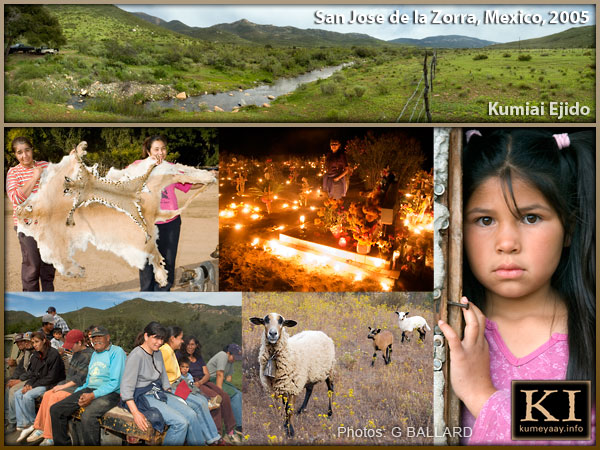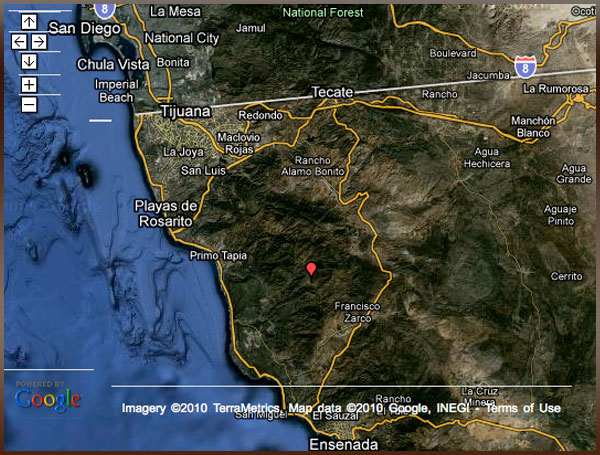Professional Photos, Writing and Web Page Design Contributed by webmaster, GARY G BALLARD
 Click on photo for a very large high-resolution picture.
Click on photo for a very large high-resolution picture.SAN JOSE DE LA ZORRA KUMEYAAY INDIGENOUS COMMUNITY 2004-2007
Para Español Traduzca esta página inglesa al español
Webmaster Forward:
After more than a decade working with the affluent northern Kumeyaay gaming tribes, I am just beginning my introduction to the southern Kumeyaay people — monetarily the southern Kumeyaay Indians are poor, yet they are rich in their aboriginal lands, Native language, traditional culture and family relationships.
As I try to understand their pictures, from my comfortable place, I DARE TO COMPARE the Mexican southern Kumeyaay financial poverty and simple lifestyle of this small Indian village ejido to how their northern Kumeyaay San Diego relatives must have existed only a few years ago prior to Indian gaming in San Diego County.
This is a COLD HARD FACT that few people stop to realize:
Prior to Indian gaming in Southern California, most of the Kumeyaay people living on and off San Diego Indian reservations were indeed living in stark Native American poverty and dependant on government assistance for food, transportation, housing, educational, medical services, the basic social services, including government welfare and food stamp programs.
Perhaps this is WHY Native American Indian gaming tribes are so fervent in protecting their livelihood today — they know the Kumeyaay History, they know about the California Indian History, and they are determined to build a better future for their children and their indigenous tribal nations.
On thing is for certain, though, the southern Kumeyaay depend greatly on what little money they make from their basketry artwork and crafts to support their families....
BAJA CALIF TRIBAL EJIDO
In December of 2004, I took the opportunity to begin taking some road trips into the Mexican Kumeyaay territory to visit the San Jose de la Zorra Kumeyaay indigenous rancherias in Valle de Guadalupe. The San Jose de la Zorra Kumeyaay Indigenous Community is one of five Kámia Kumiai Kumeyaay Indian communities in Baja California, Mexico, including La Huerta, San Antonio Necua, Santa Catarina, Juntas de Neji. An additional 13 Kumeyaay bands remain above the border in San Diego County for a total of 17 recognized Kumeyaay tribes.
By the United State's living standards, the Kumeyaay people in Jose de la Zorra are poverty stricken, closed out of most modern-world conveniences, but it is hard to not appreciate the hard work and spirit of the southern Kumeyaay aboriginal peoples and their simple lifestyles.
For example, my Kumeyaay guide told me the San Jose de la Zorra Kumeyaay Indian village was only recently being wired for electricity a month prior to my visits in December of 2004. Most, if not all of the Kumeyaay homes I visited still had no electricity and none had running water or plumbing — a trip to the restroom in this tribal village means looking for an outhouse or bush.
The road from the main highway into San Jose de la Zorra is unpaved dirt, rocky and eroded, it winds through miles of what at times seems like mountainous high desert wilderness — a beautiful unforgiving countryside. The Kumeyaay People here maintain their own roads.
Snippets of my initial on-line research:
• San Jose de la Zorra is located approximately 40 miles southeast of Tijuana in a small valley surrounded by mountainous hills at an elevation of 1,200 feet above sea level.
• Approximately 35 Indian families currently live in the valley.
• Their ancestors settled in this mountain valley permanently over 130 years ago, some after being forced south, threatened at gun point, to stay across the U.S.-Mexico border in their southern ancestral lands. The ensuing "border situation" has effectively alienated the (now) southern Kumeyaay from their (now) northern Kumeyaay relatives to the point where many of the families no longer know each other.
Some tribal leaders and private individuals are working some to de alienate these tribal relationships, but the governments' paperwork to cross the border remains an effective obstacle to most southern aboriginal Indian people wanting to cross the Mexico-U.S. border.
• The Mexico Kumeyaay Indian communities have retained much of their traditional knowledge, and appear to have a full generation of Native Kumeyaay speakers.

KUMIAI DE BAJA CALIF MEXICO en Español Kumiais una cultura en riesgo de extinsión, Acerca de los indigenas Kumiai, Geografia, Sistema Politico, Origenes lingüisticos, Programas de Trabajo, Consejo, Acerca de los indigenas Kumiai, Gobernadora Kumiai, Origenes lingüisticos
y mucho mas...

NATIVE AMERICAN Indigenous artists fine art cultural posters for sale the webmaster produced a series of 48-inch fine art posters of his photojournalistic documentary series on the California tribal peoples of North America.
KUMEYAAY.COM writer Mike Wilken (kumeyaay.com link broken) writes some very interesting information about the San Jose de la Zorra community.
ADESU.ORG is developing detailed information about the local Kumiai Mexican Indian artesanos and artesanis of San Jose de la Zorra, Baja CA, including satellite maps.
CALIFORNIA INDIAN ART:
Many of the Kamiai Kumiai Indios here earn their living today by traditional basket weaving fine California Indian baskets, including other traditional Indian arts and crafts like Native American coiled clay pottery, indigenous California bark skirts, fiber sandals, bows and arrows, war clubs, authentic Native American ethnographic arts and crafts — all made in the traditional way with the traditional materials.
Terms of Use • Privacy Statement • Site Map • Kumeyaay Indians Research

